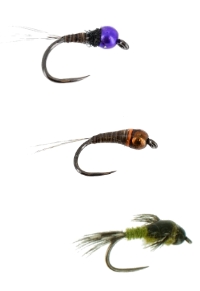Muskegon River
The Muskegon River is a large drainage that is a tributary to Lake Michigan. It flows into the east side of the lake, and it is well known for its tremendous runs of steelhead and salmon. It is also recently famous for its population of huge resident brown and rainbow trout, along with its prolific hatches due to the re-licensing of Croton Dam.
The Muskegon begins out of Houghton Lake over 200 miles away from Lake Michigan. While the upper section of the river is quite fishable, it's the lower section that recieves all of the attention, and rightfully so. With the help of Croton Dam and its cold stable water, the river contains tremendous numbers of resident brown and rainbow trout, coupled with epic runs of salmon and steelhead. The Muskegon is also an aquatic insect growing factory. It's even getting better with the new water release schedule agreed upon by Consumers Power Company (CMS Energy) which is the operator of Croton Dam. The new program came about in July of 1994 and is responsible for managing more consistent flows which have in turn stabilized the fishery. The natural reproduction of fish has risen every year since then.
The distance from Croton Dam to Lake Michigan is about 35 miles long, with the upper section from the dam to Newaygo being the most popular and productive. The river is very large averaging 200 feet across with many sections wider then 300 feet. It flows through typical Michigan land lined with beautiful pines and hardwoods. In many areas, the water is like glass with classic dry fly characteristics similar to what you would find on Pennsylvania's Delaware River, or Montana's Missouri River. Tight foam lines with trout rising to a multitude of insects is becoming increasingly more common with these new regulated flows. The riverbed consists mostly of gravel and larger rocks, while the weed growth in the river is very rich creating an ideal environment for mayflies, caddisflies, and stoneflies.
There are just as many salmon and steelhead runs, riffles, and pools as there are quiet dry fly pools here on this river. The run of Steelhead can be found in the river anytime from October through late May. The fall may be the best time to catch these fish, as they are in the river to feed heavily, and can be extremely aggressive eating almost anything that passes by them. Big egg patterns and beadhead woolly buggers are by far the ticket in the fall and early winter. Spey fishing along with swinging wet flies and large soft hackles can also get the job done. Late winter and early spring is the time for fishing lighter leaders with smaller egg patterns and nymphs. The fish at this time are cold and lethargic, and therefore a little less aggressive. Typically, they will not chase flies like they do in the fall. Late spring is another great time for steelhead fishing also. The fish can be fairly aggressive, although they can be very selective, almost like spring creek trout fishing. Fishing very small nymphs #14-16, with long and light leaders is often necessary to catch these fish. Salmon enter the river in September, and can be found in the river until mid November. Please make sure to check the State fishing regulations before fishing.
The best way to cover water on this big western style river is by drift boat. This will allow you to get to the pools and runs inaccessible to wade fisherman. However, wade anglers do catch a good share of fish at different access points along the way. A couple are found at Thornapple Avenue on the south side of the river, and at Pine Avenue on the north side, both a short distance below the dam.
The Muskegon River is a beautiful and mighty river. The opportunities this river provides are endless. With its tremendous runs of salmon and steelhead, along with its quality population of resident trout, this river is a true masterpiece, and should be a must do when fishing in Michigan.



